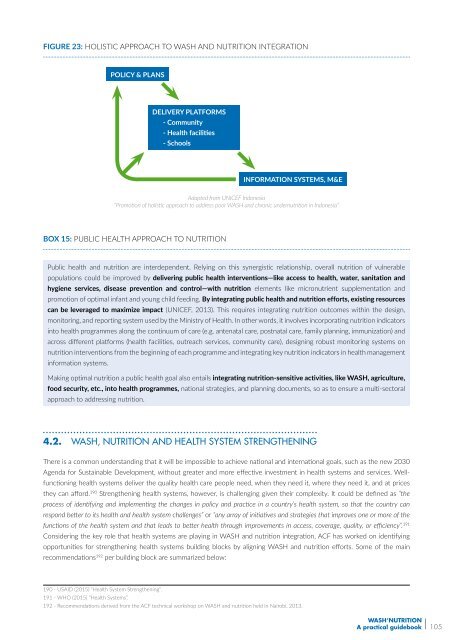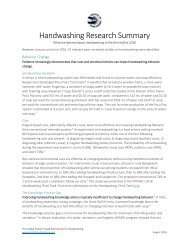WASH’ Nutrition
manuel_wash_nutrition_online
manuel_wash_nutrition_online
You also want an ePaper? Increase the reach of your titles
YUMPU automatically turns print PDFs into web optimized ePapers that Google loves.
Figure 23: Holistic approach to WASH and nutrition integration<br />
Policy & plans<br />
Delivery platforms<br />
- Community<br />
- Health facilities<br />
- Schools<br />
Information systems, M&E<br />
Adapted from UNICEF Indonesia<br />
“Promotion of holistic approach to address poor WASH and chronic undernutrition in Indonesia”<br />
BOX 15: Public health approach to nutrition<br />
Public health and nutrition are interdependent. Relying on this synergistic relationship, overall nutrition of vulnerable<br />
populations could be improved by delivering public health interventions—like access to health, water, sanitation and<br />
hygiene services, disease prevention and control—with nutrition elements like micronutrient supplementation and<br />
promotion of optimal infant and young child feeding. By integrating public health and nutrition efforts, existing resources<br />
can be leveraged to maximize impact (UNICEF, 2013). This requires integrating nutrition outcomes within the design,<br />
monitoring, and reporting system used by the Ministry of Health. In other words, it involves incorporating nutrition indicators<br />
into health programmes along the continuum of care (e.g. antenatal care, postnatal care, family planning, immunization) and<br />
across different platforms (health facilities, outreach services, community care), designing robust monitoring systems on<br />
nutrition interventions from the beginning of each programme and integrating key nutrition indicators in health management<br />
information systems.<br />
Making optimal nutrition a public health goal also entails integrating nutrition-sensitive activities, like WASH, agriculture,<br />
food security, etc., into health programmes, national strategies, and planning documents, so as to ensure a multi-sectoral<br />
approach to addressing nutrition.<br />
4.2. WASH, nutrition and health system strengthening<br />
There is a common understanding that it will be impossible to achieve national and international goals, such as the new 2030<br />
Agenda for Sustainable Development, without greater and more effective investment in health systems and services. Wellfunctioning<br />
health systems deliver the quality health care people need, when they need it, where they need it, and at prices<br />
they can afford. 190 Strengthening health systems, however, is challenging given their complexity. It could be defined as “the<br />
process of identifying and implementing the changes in policy and practice in a country’s health system, so that the country can<br />
respond better to its health and health system challenges” or “any array of initiatives and strategies that improves one or more of the<br />
functions of the health system and that leads to better health through improvements in access, coverage, quality, or efficiency”. 191<br />
Considering the key role that health systems are playing in WASH and nutrition integration, ACF has worked on identifying<br />
opportunities for strengthening health systems building blocks by aligning WASH and nutrition efforts. Some of the main<br />
recommendations 192 per building block are summarized below:<br />
190 - USAID (2015) “Health System Strengthening”.<br />
191 - WHO (2015) “Health Systems”.<br />
192 - Recommendations derived from the ACF technical workshop on WASH and nutrition held in Nairobi, 2013.<br />
<strong>WASH’</strong><strong>Nutrition</strong><br />
A practical guidebook<br />
105



